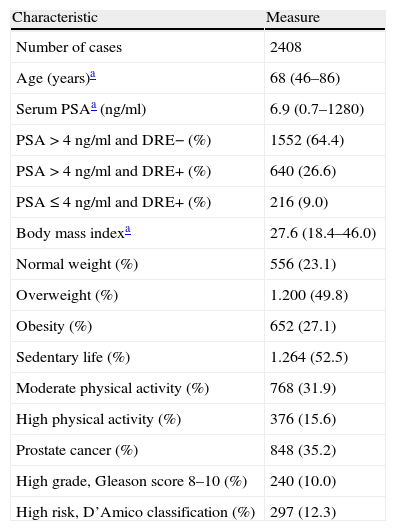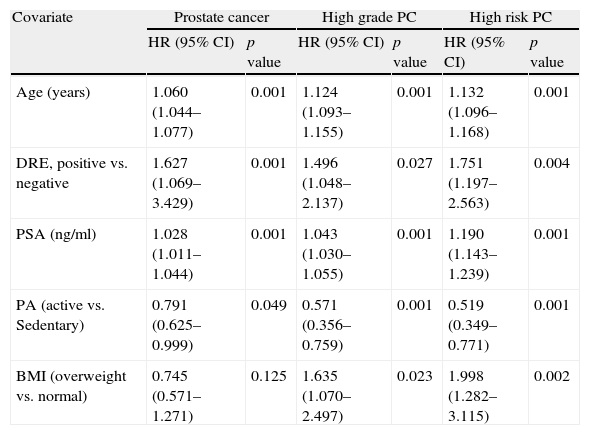To analyze the influence of sedentary (SE) and overweight (OW) in the risk of prostate cancer detection (CP) and aggressiveness.
Materials and methodsWe performed prostate biopsy (PB) to 2408 consecutive male, 5 ARIs untreated, because of elevated serum PSA above 4.0ng/mL (91%) or suspicious digital rectal examination (9%). In all ultrasound guided PB, 10 cores were obtained plus 2–8 additionals, according to age and prostate volume. Physical activity was assessed using a survey (SE vs. non-SE) and calculated body mass index (normal vs. OW>25kg/cm2). The tumor aggressiveness was evaluated according to the Gleason score (high grade «HG»: Gleason>7) and D’Amico risk (high risk «HR»: T>3a or PSA>20 or Gleason score>7).
ResultsWe found a significant association between SE (52.5%) and OW (72.9%); p<0.001. The overall PC detection rate was 35.2%. In men with SE it was 36.7% and non-SE 33.6%, p=0.048. The overall rate of AG tumors was 28.3%, 29.2% in men with SE and 27.1 in non-SE, p=0.261. The overall rate of AR tumors was 35%, 39.7% in men with SE and 29.4% non-SE, p<0.001. CP was detected in 38.1% of men with normal BMI and 34.3% in men with OW, p=0.065. HG tumor rates were 18.1% and 31.4%, respectively, p<0.001 and AR tumor rates were 22.6% and 39.2%, respectively, p<0.001. Binary logistic regression showed that SE was an independent predictor of CP, OR 0.791 (95% CI: 0.625–0.989); p=0.030. SE and OW were independent predictors of HG: OR 0.517 (95% CI: 0.356–0.752); p=0.001, and OR 1.635 (95% CI: 1070–2497); p=0.023. SE and OW were also independent predictors of HR: OR 0.519 (95% CI: 0.349–0.771); p=0.001, and OR 1.998 (95% CI: 1.281–3.115); p=0.002.
ConclusionsIn men who met criteria for prostate biopsy an association between sedentary and overweight exist. A sedentary lifestyle is associated with increased risk of PC detection while sedentary and overweight were associated with more aggressive tumors.
Analizar la influencia del sedentarismo (SE) y sobrepeso (SP) en el riesgo de detección de cáncer de próstata (CP) y su agresividad.
Material y métodoSe realizó biopsia prostática (BP) a 2.408 varones consecutivos, no tratados con 5ARI, a causa de elevación sérica del PSA por encima de 4,0ng/ml (91%) o tacto rectal sospechoso (9%). En la BP, transrectal y ecodirigida, se obtuvieron 10 cilindros, y entre 2 y 8 adicionales en función de la edad y del volumen prostático. La actividad física se evaluó mediante una encuesta (SE vs. no SE) y se calculó el índice de masa corporal (normal vs. SP:>25kg/cm2). La agresividad tumoral se evaluó según la suma de Gleason (alto grado [AG]: Gleason >7) y el riesgo de D’Amico (alto riesgo [AR]: T>3a o PSA>20 o suma de Gleason>7).
ResultadosSe halló una asociación significativa entre SE (52,5%) y SP (72,9%), p>0,001. La tasa global de detección de CP fue 35,2%. En varones con SE fue 36,7% y en no SE 33,6%, p=0,048. La tasa global de tumores de AG fue 28,3%, 29,2% en varones con SE y 27,1% en no SE, p=0,261. La tasa global de tumores de AR fue 35%, 39,7% en varones con SE y 29,4% en no SE, p<0,001. Se detectó CP en un 38,1% de hombres con IMC normal y 34,3% en hombres con SP, p=0,065. La tasa de tumores de AG fue 18,1 y 31,4% respectivamente, p<0,001, y la tasa de tumores de AR fue 22,6 y 39,2% respectivamente, p<0,001. La regresión logística binaria mostró que el SE fue un predictor independiente de CP, RR 0,791 (95% IC: 0,625-0,989), p=0,030. SE y SP fueron predictores independientes de AG: RR 0,517 (95% IC: 0,356-0,752), p=0,001, y RR 1,635 (95% IC 1,070-2,497), p=0,023. SE y SP también fueron predictores independientes de AR: RR 0,519 (95% IC: 0,349-0,771), p=0,001, y RR 1,998 (95% IC: 1,281-3,115), p=0,002.
ConclusionesEn varones que cumplen criterios de biopsia prostática se encontró una asociación entre sedentarismo y sobrepeso. El sedentarismo se asoció a mayor riesgo de detección de CP, mientras sedentarismo y sobrepeso incrementaron el riesgo de detección de tumores más agresivos.










